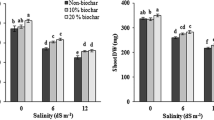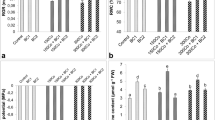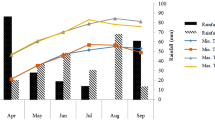Abstract
Increasing temperature poses a serious threat to rice productivity. This study investigated the impact of various biochar treatments and phosphorous (P) fertilization on osmolyte accumulation, ROS development, and antioxidant activity in two rice cultivars (IR-64 and Huanghuazhan) under high-temperature stress. All plants of both cultivars were grown in a controlled environment under ambient temperatures (AT), high day temperatures (HDT) or high night temperatures (HNT). The different fertilization treatments were biochar alone, P alone and biochar + P with control. In the leaves and xylem sap of both rice cultivars, particularly in the susceptible cv. IR-64, high-temperature stress increased the production of MDA and H2O2. HDT and HNT decreased total soluble sugars, protein, and proline levels in both rice cultivars. HNT was observed as more harmful compared to HDT during most of the studied characteristics. The response of antioxidant enzyme activities, viz, SOD, POD, CAT, APX, ASC, GSH, GR, and GSSC activities, to the temperature treatments varied between the two cultivars. Antioxidant activities decreased in the leaves and xylem sap of IR-64 but increased in those of Huanghuazhan upon exposure to high-temperature stress. Huanghuazhan exhibited better heat tolerance compared to IR-64, which was linked to its increased antioxidant enzyme activation and metabolite synthesis. As compared to the control, all soil fertilization treatments considerably reduced the adverse impacts of high temperature on the rice cultivars. The combination of biochar and P resulted in better performance compared to the other treatments in terms of all studied attributes.








Similar content being viewed by others
Data availability
The datasets used and/or analyzed during the current study are available from the corresponding author on reasonable request.
References
Akhtar SS, Li G, Andersen MN, Liu F (2014) Biochar enhances yield and quality of tomato under reduced irrigation. Agric Water Manag 138:37–44
Almeselmani M, Deshmukh PS, Sairam RK, Kushwaha SR, Singh TP (2006) Protective role of antioxidant enzymes under high temperature stress. Plant Sci 171:382–388
Alscher RG, Erturk N, Heath LS (2002) Role of superoxide dismutases (SODs) in controlling oxidative stress in plants. J Exp Bot 53:1331e1341
Apel K, Hirt H (2004) Reactive oxygen species: metabolism, oxidative stress and signal transduction. Ann Rev Plant Biol 55:373–399
Asada K, Takahashi M (1987) Production and scavenging of active oxygen in photosynthesis. In: Kyle DJ, Osmond CB, Arntzen CJ (eds) Photoinhibition. Elsevier, Amsterdam, The Netherlands, pp 227–287
Atkinson CJ, Fitzgerald JD, Hipps NA (2010) Potential mechanisms for achieving agricultural benefits frombiochar application to temperate soils: a review. Plant Soil 33:1–18. https://doi.org/10.1007/s11104-010-0464-5
Bai TH, Li CY, Ma FW, Shu HR, Han MY (2009) Exogenous salicylic acid alleviates growth inhibition and oxidative stress induced by hypoxia stress in Malus robusta Rehd. J Plant Growth Regul 28:358–366
Barker DJ, Sullivan CY, Moser LE (1993) Water deficit effects on osmotic potential, cell wall elasticity, and proline in five forage grasses. Agron J 85:270–275
Basso AS, Miguez FE, David AL, Robert H, Westgate M (2013) Assessing potential of biochar for increasing water-holding capacity of sandy soils. GCB Bioenergy 5(2):132–143
Beesley L, Moreno-Jimenez E, Gomez-Eyles JL (2010) Effects of biochar and green waste compost amendments on mobility, bioavailability, and toxicity of inorganic and organic contaminants in a multi-element polluted soil. Environ Pollut 158:2282e2287
Bradford MM (1976) A rapid and sensitive for the quantitation of microgram quantitites of protein utilizing the principle of protein-dye binding. Anal Biochem 72:248–254
Cassman KG, Wood S (2005) Cultivated Systems. In: Ecosystem and human well-being: Current state and trends: findings of the Conditions and Trends Working Group/ edited by Rashid Hassan, Robert Scholes, Neville Ash. pp 747–787.
Cook D, Fowler S, Fiehn O, Thomashow MF (2004) A prominent role for the CBF cold response pathway in configuring the low-temperature metabolome of Arabidopsis. Proc Natl Acad Sci U S A 101:15243–15248
Cui HJ, Wang MK, Fu ML, Ci E (2011) Enhancing phosphorus availability in phosphorus-fertilized zones by reducing phosphate adsorbed on ferrihydrite using rice straw-derived biochar. J Soils Sediments 11(7):1135–1141
Dash S, Mohanty N (2002) Response of seedlings to heat-stress in cultivars of wheat: Growth temperature-dependent differential modulation of photosystem 1 and 2 activity, and foliar antioxidant defense capacity. Plant Physiol 159:49–59
Demiral T, Turkan I (2004) Does exogenous glycine betaine affect antioxidative system of rice seedlings under NaCl treatment? J Plant Physiol 161:1089–1100
Dodd IC, Ngo C, Turnbull CGN, Beveridge CA (2004) Effects of nitrogen supply on xylem cytokinin delivery, transpiration and leaf expansion of pea genotypes differing in xylem cytokinin concentration. Funct Plant Biol 31(9):903–911
Dubois M, Smith F, Gilles KA, Hamilton JK, Rebers PA (1956) Colorimetric method for determination of sugars and related substances. Anal Chem 28:350–356
Eitzinger J, Orlandini S, Stefanski R, Naylor REL (2010) Climate change and agriculture: introductory editorial. J Agric Sci Camb 148:499–500
Faize ML, Burgos L, Faize A, Piqueras E, Nicolas G, Barba-Espin MJ, Alcobendas C-M, Artlip T, Hernandez JA (2011) Involvement of cytosolic ascorbate peroxidase and Cu/Zn-superoxide dismutase for improved tolerance against drought stress. J Exp Bot 62:2599e2613
Foster JG, Hess JL (1980) Responses of superoxide dismutase and glutathione reductase activities in cotton leaf tissue exposed to an atmosphere enriched in oxygen. Plant Physiol 66:482–487
Foyer CH, Rowell J, Walker D (1983) Measurement of the ascorbate content of spinach leaf protoplasts and chloroplasts during illumination. Planta 157:239–244
França MB, Panek AD, Eleutherio ECA (2007) Oxidative stress and its effects during dehydration. Comp Biochem Physiol Part A 146:621–631
Gilmour SJ, Sebolt AM, Salazar MP, Everard JD, Thomashow MF (2000) Over expression of the Arabidopsis CBF3 transcriptional activator mimics multiple biochemical changes associated with cold acclimation. Plant Physiol 124:1854–1865
Glaser B, Lehmann J, Zech W (2002) Ameliorating physical and chemical properties of highly weathered soils in the tropics with charcoal—a review. Biol Fertil Soils 35:219–230
Gonzalez JA, Gallardo M, Hila LM, Rosa M, Prado FE (2009) Physiological responses of quinoa (Chenopodium quinoa Willd.) to drought and waterlogging stresses: dry matter partitioning. Bot Stud 50:35–42
Graber ER, Meller-Harel Y, Kolton M, Cytryn E, Silber A, Rav David D, Tsechansky L, Borenshtein M, Elad Y (2010) Biochar impact on development and productivity of pepper and tomato grown in fertigated soilless media. Plant Soil 337:481–496
Hare PD, Cress WA, Staden JV (1998) Dissecting the roles of osmolyte accumulation during stress. Plant Cell Environ 21:535–553
Hasanuzzaman M, Nahar K, Fujita M (2013) Plant response to salt stress and role of exogenous protectants to mitigate salt-induced damages. In: Ahmad P, Azooz MM, Prasad MNV (eds) Ecophysiology and responses of plants under salt stress. Springer, New York, NY, USA, pp 25–87
Hendry GAF, Thorpe PC, Merzlyak MN (1993) Stress Indicators: Lipid Peroxidation. In: Hendry GAF, Grime JP (eds) Methods in comarative plant ecology. Chapman and Hall, London, pp 85–92
Hossain MA, Asada K (1984) Purification of dehydroascorbate reductase from spinach and its characterization as a thiol enzyme. Plant Cell Physiol 25:85–92
Hossain MA, Nakano Y, Asada K (1984) Monodehydroascorbate reductase in spinach chloroplasts and its participation in regeneration of ascorbate for scavenging hydrogen peroxide. Plant Cell Physiol 25:385–395
Howarth CJ (2005) Genetic improvements of tolerance to high temperature. In: Ashraf M, Harris PJC (eds) Abiotic stresses: plant resistance through breeding and molecular approaches. Howarth Press Inc, New York
Hu YL, Ge Y, Zhang CH, Ju T, Cheng W (2009) Cadmium toxicity and translocation in rice seedlings are reduced by hydrogen per oxide pretreatment. Plant Growth Regul 59:51–61
Jain M, Prasad PVV, Boote KJ, Allen LH Jr, Chourey PS (2007) Effects of season long high temperature growth conditions on sugar-to-starch metabolism in developing microspores of grain sorghum (Sorghum bicolor L. Moench). Planta 227:67–79
Jha UC, Bohra A, Singh NP (2014) Heat stress in crop plants: its nature, impacts and integrated breeding strategies to improve heat tolerance. Plant Breeding 133(6):679–701
Kammann CI, Linsel S, Gößling JW, Koyro HW (2011) Influence of biochar on drought tolerance of Chenopodium quinoa Willd and on soil–plant relations. Plant Soil 345:195–210
Kaplan F, Kopka J, Haskell DW, Zhao W, Schiller KC, Gatzke N, Sung DY, Guy CL (2004) Exploring the temperature stress metabolome of Arabidopsis. Plant Physiol 136:4159–4168
Kumar P, Tewari RK, Sharma PN (2008) Cadmium enhances generation of hydrogen peroxide and amplifies activities of catalase, peroxidases and superoxide dismutase in maize. J Agron Crop Sci 194:72–80
Lehmann J, Gaunt J, Rondon M (2006) Biochar sequestration in terrestrial ecosystems—a review. Mitig Adapt Strat Glob Chang 11:395–419
Liu X, Huang B (2000) Heat stress injury in relation to membrane lipid peroxidation in creeping bentgrass. Crop Sci 40:503–510
Major J, Rondon M, Molina D, Riha SJ, Lehmann J (2010) Maize yield and nutrition during 4 years after biochar application to a Colombian savannah oxisol. Plant Soil 333:117e128
Nagai T, Makino A (2009) Differences between rice and wheat in temperature responses of photosynthesis and plant growth. Plant Cell Physiol 50:744–755
Nakano Y, Asada K (1981) Hydrogen peroxide is scavenged by ascorbate specific peroxidase in spinach chloroplasts. Plant Cell Physiol 22:867–880
Parvage MM, Ulen B, Eriksson J, Strock J, Kirchmann H (2013) Phosphorus availability in soils amended with wheat residue char. Biol Fertil Soils 49:245–250
Porter JR (2005) Rising temperatures are likely to reduce crop yields. Nat 436:174
Prithiviraj B, Perry LG, Badri DV, Vivanco JM (2007) Chemical facilitation and induced pathogen resistance mediated by a root-secreted phytotoxin. New Phytol 173:852–860
IPCC (Intergovernmental Panel on Climate Change) (2007). Climate change and its impacts in the near and long term under different scenarios. In: The Core Writing Team, RK Pachauri & A Reisinger (Eds) Climate Change 2007: Synthesis Report, pp 43–54. Geneva, Switzerland: IPCC.
Rahayu YS, Walch-Liu P, Neumann G, Römheld V, Wirén NV, Bangerth F (2005) Root-derived cytokinins as longdistance signals for NO3 −induced stimulation of leaf growth. J Exp Bot 56(414):1143–1152
Rondon MA, Lehmann J, Ramírez J, Hurtado M (2007) Biological nitrogen fixation by common beans (Phaseolus vulgaris L.) increases with bio-char additions. Biol Fertil Soils 43:699–708
Ruan YL, Jin Y, Yang YJ, Li GJ, Boyer JS (2010) Sugar input, metabolism, and signaling mediated by invertase: roles in development, yield potential, and response to drought and heat. Mol Plant 3:942–955
Sairam RK, Tyagi A (2004) Physiology and molecular biology of salinity stress tolerance in plants. Curr Sci 86:407–421
Sairam RK, Srivastava GC, Saxena DC (2000) Increased antioxidant activity under elevated temperatures, a mechanism of heat stress tolerance in wheat genotypes. Biol Plant 43:245–251
Sakamoto A, Murata N (2002) The role of glycine betaine in the protection of plants from stress: clues from transgenic plants. Plant Cell Environ 25:163–171
Schöffl F, Prandl R, Reindl A (1999) Molecular responses to heat stress. In: Shinozaki K, Yamaguchi-Shinozaki K (eds) Molecular responses to cold, drought, heat and salt stress in higher plants. R. G. Landes Co, Austin, Texas, pp 81–98
Shi WM, Muramoto Y, Ueda A, Takabe T (2001) Cloning of peroxisomal ascorbate peroxidase gene from barley and enhanced thermotolerance by overexpressing in Arabidopsis thaliana. Gene 273(1):23–27
Smertenko A, Draber P, Viklicky V, Opatrny Z (1997) Heat stress affects the organization of microtubules and cell division in Nicotiana tabacum cells. Plant Cell Environ 20:1534–1542
Smith IK (1985) Stimulation of glutathione synthesis in photorespiring plants by catalase inhibitors. Plant Physiol 79:1044–1047
Stavi I, Lal R (2013) Agroforestry and biochar to offset climate change: a review. Agron Sustain Dev 33:81–96. https://doi.org/10.1007/s13593-012-0081-1
Velikova V, Yordanov I, Edreva A (2000) Oxidative stress and some antioxidant systems in acid rain-treated bean plants. Protective role of exogenous polyamines. Plant Sci 151:59–66
Ventura M, Sorrenti G, Panzacchi P, George E, Tonon G (2013) Biochar Reduces short-term nitrate leaching from a horizon in an apple orchard. J Environ Qual 42:76–82
Wang Y, Yin R, Liu R (2014) Characterization of biochar from fast pyrolysis and its effect on chemical properties of the tea garden soil. J Anal Appl Pyrol 110:375–381
Waraich EA, Ahmad R, Ashraf MY, Saifullah AM (2011) Improving agricultural water use efficiency by nutrient management in crop plants. Acta Agric Scand Sect B Plant Soil Sci 61(4):291–304
Waraich EA, Ahmad R, Halim A, Aziz T (2012) Alleviation of temperature stress by nutrient management in crop plants: a review. J Soil Sci Plant Nutr 12:221–244
Xu S, Li J, Zhang X, Wei H, Cui L (2006) Effects of heat acclimation pretreatment on changes of membrane lipid peroxidation, antioxidant metabolites, and ultrastructure of chloroplasts in two cool-season turfgrass species under heat stress. Environ Exp Bot 56:274–285
Zhang JH, Huang WD, Liu YP, Pan QH (2005) Effects of temperature acclimation pretreatment on the ultrastructure of mesophyll cells in young grape plants (Vitis vinifera L. cv. Jingxiu) under crosstemperature stresses. J Integr Plant Biol 47:959–970
Zhang S, Hu J, Zhang Y, Xie XJ, Knapp A (2007) Seed priming with brassinolide improves lucerne (Medicago sativa L.) seed germination and seedling growth in relation to physiological changes under salinity stress. Aus J Agric Res 58:811–815
Acknowledgements
This project was funded by the deanship of scientific research (DSR) at King Abdulaziz University, Jeddah, under Grant No. G: 463-130-1440. The authors, therefore, acknowledge with thanks DSR for technical and financial support.
Funding
This project was funded by the deanship of scientific research (DSR) at King Abdulaziz University, Jeddah, under Grant No. G: 463-130-1440. The authors, therefore, acknowledge with thanks DSR for technical and financial support.
Author information
Authors and Affiliations
Contributions
Hesham Alharby;: Conceptualization, Data curation, Visualization. Atif Bamagoos: Supervision, Project administration, Funding acquisition Investigation, Methodology, Resources. Atif Bamagoos: Investigation, Software, Validation. Shah Fahad: Methodology, Validation, Writing—review & editing. All authors have read and agreed to the published version of the manuscript.
Corresponding author
Ethics declarations
Competing interests
The authors declare that they have no competing interests.
Ethical approval
Not applicable.
Consent to participate
Informed consent was obtained from all individual participants included in the study. Additional informed consent was obtained from all individual participants for whom identifying information is included in this article.
Consent to publish
Our manuscript does not contain data from any individual person, so it is “Not applicable.”
Additional information
Publisher's Note
Springer Nature remains neutral with regard to jurisdictional claims in published maps and institutional affiliations.
Rights and permissions
About this article
Cite this article
Bamagoos, A., Alharby, H. & Fahad, S. Biochar coupling with phosphorus fertilization modifies antioxidant activity, osmolyte accumulation and reactive oxygen species synthesis in the leaves and xylem sap of rice cultivars under high-temperature stress. Physiol Mol Biol Plants 27, 2083–2100 (2021). https://doi.org/10.1007/s12298-021-01062-7
Received:
Revised:
Accepted:
Published:
Issue Date:
DOI: https://doi.org/10.1007/s12298-021-01062-7




